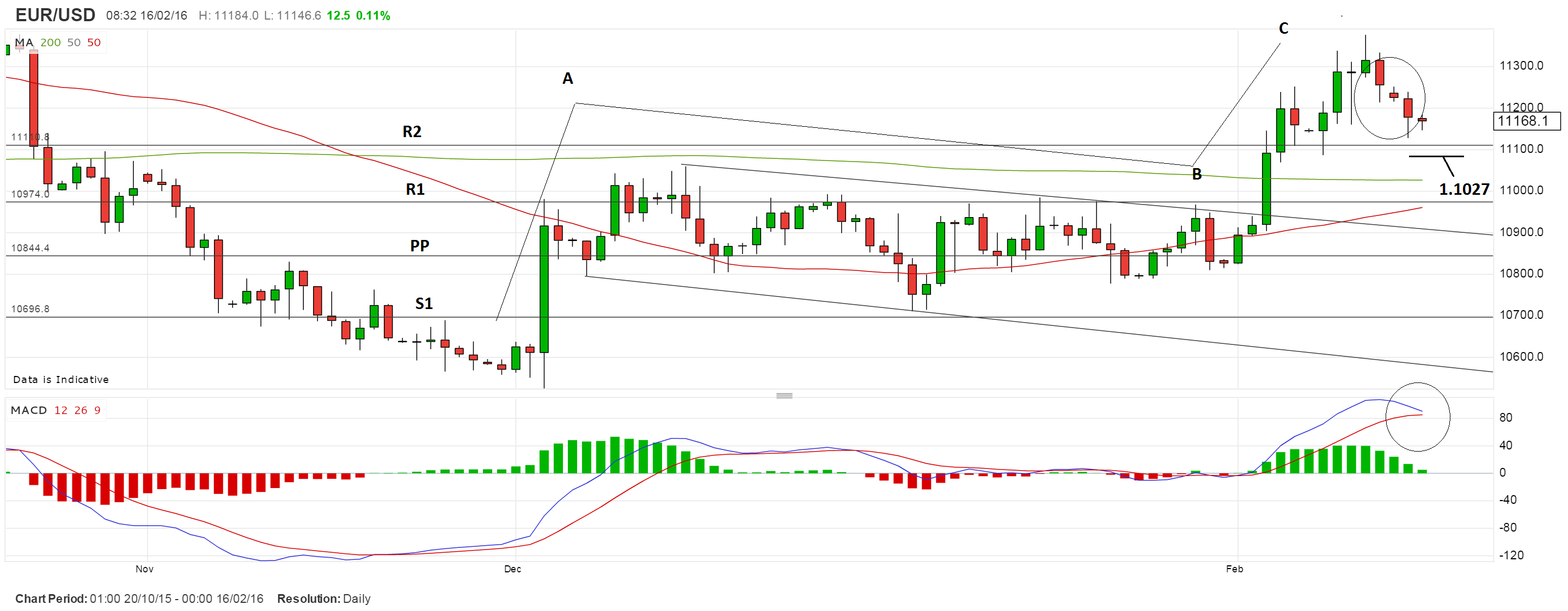Under-Pressure EUR/USD Exchange Rate Looks to Form a Tentative Base, Longer-Term Risks are to the Downside
The euro exchange rate complex closed lower for the 5th day in a row mid-week but downside momentum is waning. We explore the possibility of whether a bounce higher is now likely.

The EUR to USD conversion is appearing to steady at levels just above the 1.11 handle in line with the failure of the US dollar index to breach the 97 mark.
The coincidence here confirms that the US dollar is in the driving seat here.
Therefore moving forward we will be watching the US dollar side of the equation and questioning whether it can extend its advance which, while 6 days old, appears to be fading.
We will be watching for the EUR/USD to record its first up day in 6 days this evening, if it does we will begin to ask whether the move lower has failed.
"EURUSD beating 1.1161 could see a rally to test 1.1231 but unlikely to sustain major gains as current technical viewpoint suggests downside bias is still in command," says a strategy note from Hong Leong Bank.
The many strata of support lying below the current level, including the R2 monthly pivot at 1.1115, the 200-day MA at 1.1027 and the R1 pivot at 1.0975 are obstacles to further declines.
So despite the bearish signal I would be cautious about forecasting more downside - especially any strong moves lower - on the basis of this strong support.
Nevertheless, a break below the 1.1095 level would probably be sufficient to confirm an extension down to the 200-day ay 1.1027.
A sell signal from the MACD indicator (a momentum study) situated in the panel beneath the chart, would also help provide supporting evidence of more selling. This would be given if the MACD line (blue) crossed the signal line (red).
In the longer term, the technical structure favours a bearish bias as long as resistance holds argues Yann Quelann at Swissquote Bank.
The analyst argues key resistance is located region at 1.1453 (range high) and 1.1640 (11/11/2005 low) is likely to cap any price appreciation.
"The current technical deteriorations favours a gradual decline towards the support at 1.0504 (21/03/2003 low)," argues Quelann.
Sentiment Towards USD Turns More Positive
As we mentioned, the US dollar index has failed to advance beyond the 97 marker confirming US dollar bullishness is waning.
Nevertheless, the underlying picture is one of a market settling down after panicking that the US Federal Reserve may shy away completely from raising interest rates in 2016.
Consistent with post-FOMC meeting commentary from various Fed speakers of late, the minutes from the January FOMC seemed to confirm that the prospects of a near-term second rate hike have diminished considerably since the turn of the year.
"That said, the Fed has not yet thrown in the towel. It it clear though that the Fed clearly senses more risk around the external outlook," notes Quek Ser Leang at U.O.B in Singapore.
The USD caught a bid on news that Industrial Production rose 0.9% m/m in January, well above consensus expectations for a 0.4% gain.
The upside surprise in January industrial production growth was relatively broad-based across industry groups ensuring the US dollar enjoyed fresh buying interest.
Manufacturing production, which accounts for three-quarters of total US industrial output, rose 0.5% m/m (forecast: 0.2%).
Motor vehicle and parts production increased 2.8% on the month.
Markets Nervous on the Euro and ECB
The euro has meanwhile found no corresponding positive data which has ensured the euro continues to find buying interest in short supply.
It was surely no surprise to see a decline in the ZEW expectations indices this week, with the overall Euro area index falling to its lowest level since October 2014.
However, there was very little sign of this spilling over into analysts’ assessment of the current situation; the euro area index fell 0.5pps, and whilst Germany’s index fell 7.4pts it still sits at a lofty 52.3.
"With these sort of disappointing data, markets are likely to look closer to the ECB on its next steps," suggests the Hong Leong note.
ECB President Mario Draghi’s testimony in Brussels on Monday gave some cluse when he said that the ECB was “ready to act” at the March meeting.
Draghi said that the ECB would act if either of two conditions were met.
The first was a material slow-down in the rise of Eurozone inflation as a result of global factors, such as falling emerging market growth or plunging oil prices, and whether this had caused substantial “imported low-inflation” on “domestic wage growth, price formation and inflation expectations.”
The second was: “..the state of transmission of our monetary impulses by the financial system and in particular by banks.”
Whether or not these conditions are being tested in the eyes of the ECB are hard to gauge but markets took caution and reacted by selling the euro, which fell from 1.1249 to 1.1124.





